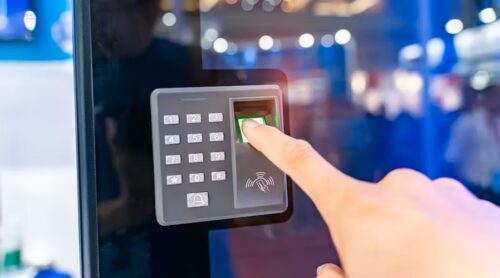
2.14.24 – SIW – Andrew Froehlich
Improvements and reduced costs in biometrics are making them a more viable option for buildings where additional security is needed.
Defending smart building technologies from external intrusion threats is essential. But just as important is securing physical access to critical building assets and occupant life-saving systems. As access control moves beyond lock and key–and even the digital key card–to more advanced biometrics, access control systems are a great way to add extra protection while simplifying usability for those who need it. Let’s look at biometrics systems, recent advancements in biometric technologies and the best ways to implement them into smart buildings.
What Are Biometrics Systems?
Biometrics involves using technology to identify specific individuals using unique physical characteristics automatically and accurately. Like a snowflake, each of us has specific physical features that can be used as a signature or password and that cannot be easily replicated. Common examples of biometrics methods include:
- Fingerprints
- Face recognition
- Voice recognition
- Signature
- Eye/iris recognition
- Hand geometry
- Walking gate
Recent advancements in biometrics systems
For most of us, using biometrics to gain access to smartphones, tablets and PCs is already well-established and well-understood. Many biometrics systems have evolved to the point where they’re highly accurate, can be purchased reasonably and leverage advanced artificial intelligence. However, when it comes to smart building access control, biometrics for authentication has lagged. That’s rapidly changing, however, as the building access control market has recently exploded to include a host of systems that deliver improved physical security and convenience compared to legacy access control methods. Some emerging biometrics technologies include:
Fingerprint access control systems. These systems are growing increasingly cost-effective, are delivered in small form-factors, use a centrally managed dashboard and are networked and powered using PoE. Additionally, built-in APIs allow for data sharing across multiple building management systems for auditing and alerting purposes.
Voice pattern recognition access control systems. For high-security areas such as in-building data centers where touchless access is required, but the deployment of facial profile cameras is not possible or visual verification is limited, voice pattern recognition access control systems have come a long way. By identifying users by their unique patterns, pitches and modulation, hands-free access control is ideal in locations where users will be carrying heavy equipment.
Facial profile access control systems. A completely touchless system using highly accurate facial recognition provides secure access and maps all visitors within a building, which can be used for physical security and health safety purposes such as preventing property theft or identifying contaminated areas. These devices are simple to deploy using PoE and offer centralized management and Northbound API data feeds for interoperability with third-party building management systems.
Iris scan access control systems. While the ability to verify users based on unique patterns of an individual’s iris has been around for a while, high costs have prevented the technology’s widespread deployment. However, smaller and more affordable iris scanner systems with improved algorithms thanks to AI have recently flooded the enterprise market, which makes them more appealing. Delivering higher accuracy compared to facial recognition, iris scanners are ideal in high-security areas where access must be tightly controlled.
Creating a plan to research, purchase and deploy biometrics
When seeking to deploy biometrics access control systems, the first step to consider is the locations and areas of a building where access control is required. The various technologies outlined in this article may be better suited for specific traffic loads and deployment options. For example, exterior door access may be better suited using fingerprint and facial recognition biometrics. At the same time, areas that must be more secure and have limited hardware deployment options may opt for voice and iris scan recognition systems.
Additionally, be careful to ensure operability with other in-building technologies, such as building management systems, remote access connectivity and ease of management. Fingerprint and facial recognition systems are easier to manage than voice and iris scan systems. Thus, these systems may be preferred for larger numbers of people as they are more convenient to manage.
Finally, cost will always play into the biometrics access control equation. Face and voice recognition tends to be on the lower end of the scale, while iris scanners tend to be the most expensive despite the technology cost trending downward. A combination of different biometrics technology options might be selected depending on the specific access control use case.

As a highly regarded network architect and trusted IT consultant with worldwide contacts, Andrew Froehlich counts over two decades of experience and possesses multiple industry certifications in the field of enterprise networking. Andrew is the founder and president of Colorado-based West Gate Networks, which specializes in enterprise network architectures and data center build-outs. He’s also the founder of an enterprise IT research and analysis firm, InfraMomentum. As the author of two Cisco certification study guides published by Sybex, he is a regular contributor to multiple enterprise IT-related websites and trade journals with insights into rapidly changing developments in the IT industry.
